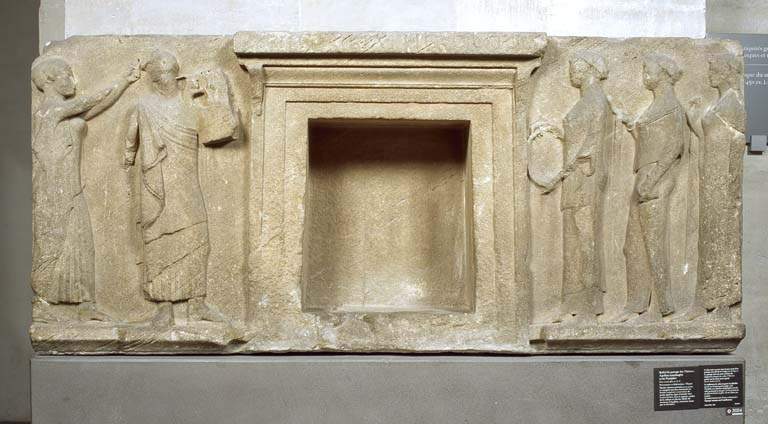The Louvre sent to Greece three large plaster casts of two important Greek bas-reliefs that arrived in Paris from the island of Thassos (Thassos) in 1865. The history of this donation is rather complicated and begins far back in 1864, when the Hellenist and bibliophile Emmanuel Miller, director of the library of the Assemblée Nationale and professor of modern Greek at the École des langues orientales vivantes, was sent on a mission to Greece by Napoleon III. From his visit, Miller returned with the two large reliefs that became part of the Louvre’s collection in 1865 and can still be seen in the Paris museum.
Their story is in some ways similar to that of the famous Elgin Marbles: in fact, Miller removed them from their original location on the island of Thasos upon the authorization of the viceroy of Egypt who then administered the island: Greece, at the date of the expedition, had already become independent, but the island of Thasos (which had attempted to escape Ottoman authority during the Greek War of Independence, but failed) would not be united with the rest of the nation until 1912, when it was conquered by the Greek navy during the First Balkan War. The two large marble reliefs date from around 480 B.C. and depict one Hermes and the Graces and the other Apollo and the nymphs: they originally decorated one of the corners of the agora of Thassos, known as the “passage of the Theorians,” as the names of the Theorians (public administrators of ancient Greece) were affixed to it after its construction. Like all ancient sculptures, these were also painted, and framed two niches in which offerings were placed by the populace (a long inscription instructed citizens on which animals to sacrifice to the god Apollo).
The casts that France sent to Thassos, on the other hand, date from between 1884 and 1932, were made in France, and sending them to Greece is seen as a way for visitors to Thassos to also discover this important vestige of the island’s heritage, albeit with a reproduction and not the original. The operation stems from a collaboration between the Louvre and the Greek Ministry of Culture, on which the Thassos museum, where the casts will be displayed, depends: the Parisian museum had donated the models in 2007, but it had not been possible to transfer them because it lacked the funds for the trip to Greece. Now, however, funding has been found and the casts have therefore been able to leave the French capital for the island in northern Greece.
“The three reliefs,” Stavroula Dadaki, director of the ephorate of antiquities in the province of Kavala-Thasos, told the newspaper Kathimerini, “were found in 1864 by archaeologist Emmanuel Miller in the first archaeological excavation attempt in Thasos. Along the way were found stones engraved with the names of the island’s administrators, hence the name Thassos Passage. The reliefs were then transferred to Paris and have since been on display at the louvre. The plaster casts were kept in the storerooms of the Louvre’s department of Greek, Etruscan and Roman antiquities.” For some years the island of Thassos had been trying to have them sent: with funding secured partly by the École française in Athens and partly by a Thassos marble company, it was therefore possible to get them there. They will now be included in the tour of the Thassos Archaeological Museum. The École française and the ephorate of antiquities in Kavala-Thasos are planning, for this summer (if epidemiological conditions permit) a series of events to celebrate the arrival of the casts.
Pictured is one of the original reliefs preserved at the Louvre.
 |
| Louvre donates casts of two important bas-reliefs brought to France in 1864 to Greece |
Warning: the translation into English of the original Italian article was created using automatic tools. We undertake to review all articles, but we do not guarantee the total absence of inaccuracies in the translation due to the program. You can find the original by clicking on the ITA button. If you find any mistake,please contact us.